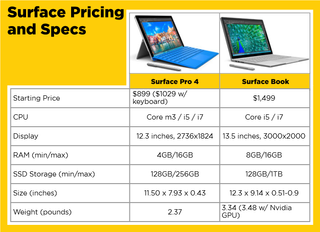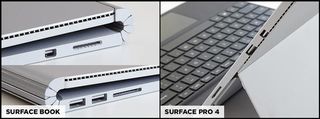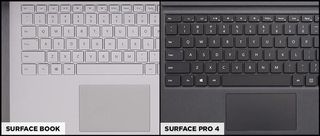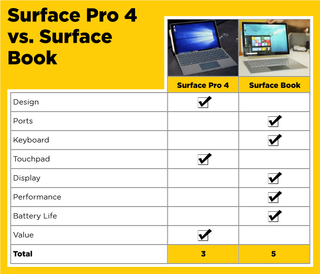Surface Pro 4 vs. Surface Book: Which Is Right for You?

If you have more than $1,000 to spend on a 2-in-1, Microsoft has two compelling choices in the Surface Pro 4 (starting at $1,029 with keyboard) and the Surface Book (starting at $1,499). While both devices can function as either a tablet or a laptop, they have a lot of differences, ranging from their designs to their keyboards and battery lives. So which is really best? To find out, we put the Surface Book and the Surface Pro 4 head-to-head in eight categories.
Design
The Surface Pro 4, like its predecessors, is a tablet first and a laptop second. The 12.3-inch slate portion measures 11.45 x 7.8 x .33 inches and weighs a reasonable 1.73 pounds. With the Type Cover keyboard attached, the weight climbs a little, to 2.37 pounds, and the thickness increases to 0.43 inches. The Pro 4's relatively light weight is a double-edged sword, because its lack of bulk leads to a more top-heavy feeling on the lap and a less-substantial-feeling keyboard. Still, the kickstand makes it easy to position the tablet on any table or balance it on your lap.
The Surface Book weighs a lot more overall, tipping the scales at 3.34 pounds and measuring 12.3 x 9.1 x .9 inches. However, its 13.5-inch tablet portion, when detached, weighs 1.6 pounds — a little less than the Surface Pro 4. Heft aside, the Surface Book has a number of advantages, including a more lap-friendly weight distribution and an attractive fulcrum hinge. The magnetic connection between the keyboard and the slate is particularly innovative, as it holds steadily but detaches fairly easily.
MORE: Microsoft Surface Pro 4: Full Review
However, you have to press a button first to detach the Surface Book's screen; the Surface Pro 4 separates from the Type Cover with just a tug.

Winner: Surface Pro 4. The Surface Book has a lot more innovation in its attractive body. However, if you need a lightweight device, the Surface Pro 4 is a better choice, and it's easier to switch from laptop mode to tablet mode.
Ports
Because the Surface Book has a thicker body, it has more room for a lot more ports. The Surface Pro 4 has a single USB 3.0 port, a mini DisplayPort, a microSD card reader and a 3.5mm audio jack. The Surface Book has a similar collection of ports but substitutes a full-size SD card slot for microSD and throws in an additional USB port for good measure.
Stay in the know with Laptop Mag
Get our in-depth reviews, helpful tips, great deals, and the biggest news stories delivered to your inbox.

Winner: Surface Book. This laptop wins by a single USB port.
Keyboard
Both devices provide a strong typing experience, with good tactile feedback and plenty of vertical travel. The Surface Book has slightly deeper keys, offering 1.5 mm of travel compared to the Pro 4's 1.4 mm, but the Pro 4's keys offered much snappier feedback.
However, the Pro 4's wafer-thin, 0.6-pound Type Cover just doesn't provide as much support as its sibling's meaty keyboard base. When I held the Surface Pro 4 on my lap, the board felt like a trampoline under my keystrokes, whereas it held firm on the Surface Book. Even on a table, my wrists were more comfortable pressing against the larger, thick metal palm rest.

Winner: Surface Book. It's more laptoplike because it is one.
MORE: Surface Book (Core i5, Integrated GPU): Full Review
Touchpad
The Surface Book has a slightly larger touchpad, measuring 4.1 x 2.8 inches, but the Surface Pro 4's 4 x 2-inch pad offers a slightly smoother and more accurate feel. Whether I was scrolling down Web pages or pinch-zooming, moving my fingers on the Pro 4's pad just felt more natural.
I also found that I could move my pointer across the desktop in one or two easy movements, rather than picking up my fingers and reswiping several times as I did on the Surface Book. When clicking down, I found that the Pro 4's touchpad provided much better tactile feedback.

Winner: Surface Pro 4. Smoother performance wins.
Display
Both the Surface Pro 4 and the Surface Book have higher-than-HD screens that display bright, rich and accurate colors. The Pro 4's 12.3-inch display has a resolution of 2736 x 1824 pixels, compared to the 13.5-inch Surface Book's 3000 x 2000 pixels. The panels have an identical sharpness of 267 pixels per inch and very similar brightness, measuring 382 and 387 nits, respectively, on our scale.
Both devices can display a wide range of colors: The Pro produced 99.7 percent of the sRGB spectrum on our tests, while the Book managed a similar mark of 98.5 percent. Both panels were also extremely accurate, with Delta-E error rates of 0.35 and 0.57, respectively (0 is perfect).
However, when we put the two displays side by side and watched both a 4K trailer for Suicide Squad and a 1080p trailer for Star Wars: The Force Awakens, the Surface Book's screen emerged as the clear victor. Both devices offered sharp images, but the colors were warmer and more vibrant on the Book's 13.5-inch panel. The red in Kylo Ren's lightsaber and greens, like the laser blasts in a space dogfight, really popped on the larger display. The Surface Pro 4's images had a bit of a blue tint, making the sand in the deserts of Jakku and the red on Poe Dameron's flight suit look dull by comparison. The white of Stormtroopers' armor was also a lot whiter on the Book than on the Pro.

Winner: Surface Book. Both screens rock, but the Surface Book has the edge in real-world performance.
Performance
Both high-end Surface devices are available with a variety of Intel 6th-Generation Core Series CPUs and, if similarly configured, should offer nearly identical performance. When we tested a Surface Book and a Surface Pro 4, both of which had Intel Core i5-6300U CPUs and 8GB of RAM, the devices scored 6,811 and 6,814 respectively on Geekbench 3, a test that measures overall system speed. The two devices finished our Spreadsheet Performance test, which matches 20,000 names with their addresses in OpenOffice Calc, in 4:17 and 4:11 — an irrelevant difference of just 6 seconds. Their SSDs both recorded speeds of exactly 318 MBps on our file-transfer test.
However, if you want the highest possible level of performance, you should consider purchasing a Surface Book configuration that comes with a discrete Nvidia GPU, something you can't get on a Surface Pro 4. With discrete graphics and a Core i7 CPU on board, the Surface Book returned an impressive 82 frames per second in World of Warcraft, whereas the Surface Pro 4 managed only 47 fps at the same settings (1080p, autodetect).

Winner: Surface Book. With the same specs, you get the same performance, but if you're willing to spend more, you can get discrete graphics on the Surface Book.
Battery Life
There's a huge difference in overall battery life between the two devices. The Surface Book lasted a superb 12 hours and 29 minutes on our battery test, which involves continuous Web surfing over Wi-Fi, while the Surface Pro 4 managed just 6 hours and 5 minutes — hardly enough for a full day. However, if you want to use the Surface Book as a tablet rather than a laptop, you get just 1 hour and 53 minutes with the keyboard detached.

Winner: Surface Book. Microsoft's laptop has serious staying power.
Value
At first glance, the laptop-centric Surface Book appears to be in a different price band because it carries a starting price of $1,499, but if you want a Surface Pro with more than basic specs, you're looking at a much smaller price delta. The base-level Surface Pro costs $899 but comes with a low-end, Intel Core m3 CPU, just 4GB of RAM, a 128GB SSD and no keyboard.
If you want to upgrade to a Core i5 CPU with the same RAM and storage, it's $999 plus $130 for the keyboard ($1,129). However, if you want 8GB of RAM, you have to also get at least a 256GB SSD, so the cost jumps to $1,299 plus the keyboard, or $1,429. That's just $70 less than the entry-level Surface Book, which also has a Core i5 CPU and 8GB of RAM but comes with a 128GB SSD.
Winner: Surface Pro 4, by a hair. If you're willing to accept less RAM and/or a slower CPU, the Surface Pro 4 can be significantly cheaper than its sibling, but when you're buying a premium device in the $1,000 range, you'll probably want to spend the extra money to get proper specs.
Overall Winner: Surface Book
The Surface Book comes out comfortably ahead of the Pro 4, thanks to its superior battery life, more colorful screen and better typing experience. The Surface Book also offers discrete graphics (if you're willing to pay extra).
However, if you intend to use this device as a tablet first and foremost, the Surface Pro 4 is a better choice because of its lighter weight, longer battery life in slate mode and lower price. Otherwise, if you can afford its high starting price and want a superior productivity experience, go for the Surface Book.


